Filly Fetches Top Dollar at Auction
- Share via
BURNS, Ore. — When the bidding started Saturday on a 6-month-old Kiger mustang filly fresh off the range, 91-year-old retired wildlife biologist Bob Smith sat in the front row and kept his yellow bidding card held high.
When Smith finally laid his bidding card in the blanket covering his legs, the crowd of some 500 people packing the Harney County Fairgrounds grandstands for the first Kiger mustang auction shook their heads in disbelief, clapped and thumped each other on the back.
Smith had agreed to pay a record $19,000 for the privilege of adopting the wild horse of his dreams.
“Most wild horses are just that, feral horses,” said Smith, looking like anything but a high roller in a crumpled felt hat, faded green quilted jacket and frayed tan slacks. “But these are the Spanish mustangs.
“I’ve wanted a real bona fide mustang most all of my life,” said Smith, who worked as a buckaroo in his youth and a biologist for the U.S. Fish and Wildlife Service before retiring. “I probably won’t be around by the time the next one of these comes around.”
Back in 1971 when the U.S. Bureau of Land Management began rounding up wild horses to keep them from overgrazing public range land, many ranchers considered them no better than coyotes, to be shot on sight.
But each year the buzz has been building on those showing colors and traits of the Sorraias, Andalusians, Garranos and Spanish Barbs that the Spanish brought to the New World in the 16th and 17th centuries--especially the Kigers, which make their home in the high desert of southeastern Oregon on the flanks of Steens Mountain.
With demand growing, the bureau two years ago abandoned the lotteries held to award adoption picks, and the $125 adoption fee, in favor of competitive bidding. Because the Kigers are rounded up only every three years, this was the first time they had been adopted by auction.
The price Smith paid doesn’t approach the $50,000 that Steven Spielberg’s DreamWorks studio purportedly paid Oregon breeder Bill Littleton for Donner, a ranch-bred Kiger stud that will serve as the model for the upcoming animated motion picture “Spirit.”
But it easily doubled anything paid at a Bureau of Land Management wild horse auction and was half-again the high end for ranch-bred Kigers.
The next highest at Saturday’s auction was a 2-year-old filly for $2,500. The top stud was a 1-year-old that went for $2,100.
“It’s unreal, isn’t it?” said Mack Isley of Pasco, Wash., the president of the Kiger Musteno Assn. “It looks like some people are finally beginning to realize the value of these horses. It isn’t just the Kiger. It’s all wild horses.”
The Kigers were first rounded up in 1974 on Beaty Butte, where Bureau of Land Management Burns District wild horse manager Ron Harding had heard there might be horses exhibiting the dun factor characteristic of the old Spanish breeds. They were moved to a range management area along Kiger Creek, which flows off Steens Mountain.
The dun factor shows four colors. Dun is golden with black points. Red dun is reddish. Grulla (pronounced the Spanish way, GROO-ya) is a warm mouse-gray. Claybank, the rarest, is similar to buckskin.
The most sought-after horses have zebra striping on their legs, a dorsal stripe down the back, fine muzzles, eyes wide apart and hooked ears with dark outlines and tufts of hair at the bottom.
Smith said he knew immediately upon seeing the little filly in the viewing pens on Friday that she was the horse he wanted, no matter what it cost.
He liked her light dun color, the good zebra striping on her legs, her fine head and overall conformation.
“I brought him a lawn chair and he just sat and watched her for an hour,” said his friend and trainer Coni Floray. “It’s a dream come true.”
More to Read
Sign up for Essential California
The most important California stories and recommendations in your inbox every morning.
You may occasionally receive promotional content from the Los Angeles Times.













